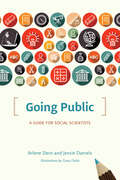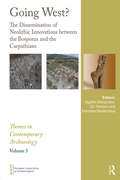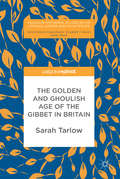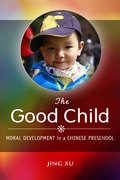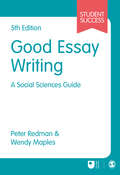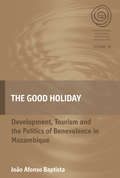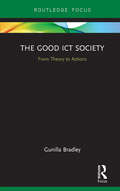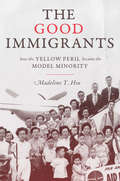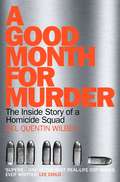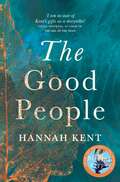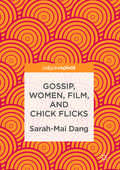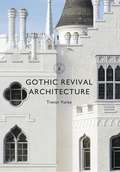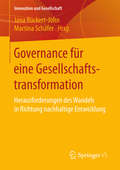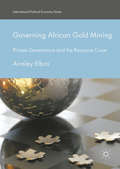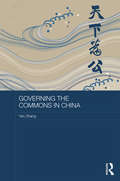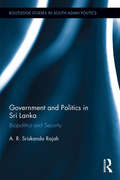- Table View
- List View
Going Public: A Guide for Social Scientists (Chicago Guides to Writing, Editing, and Publishing)
by Arlene Stein Jessie DanielsAt a time when policy discussions are dominated by “I feel” instead of “I know,” it is more important than ever for social scientists to make themselves heard. When those who possess in-depth training and expertise are excluded from public debates about pressing social issues—such as climate change, the prison system, or healthcare—vested interests can sway public opinion in uninformed ways. Yet few graduate students, researchers, or faculty know how to do this kind of work—or feel empowered to do it. While there has been an increasing call for social scientists to engage more broadly with the public, concrete advice for starting the conversation has been in short supply. Arlene Stein and Jessie Daniels seek to change this with Going Public, the first guide that truly explains how to be a public scholar. They offer guidance on writing beyond the academy, including how to get started with op-eds and articles and later how to write books that appeal to general audiences. They then turn to the digital realm with strategies for successfully building an online presence, cultivating an audience, and navigating the unique challenges of digital world. They also address some of the challenges facing those who go public, including the pervasive view that anything less than scholarly writing isn’t serious and the stigma that one’s work might be dubbed “journalistic.” Going Public shows that by connecting with experts, policymakers, journalists, and laypeople, social scientists can actually make their own work stronger. And by learning to effectively add their voices to the conversation, researchers can help make sure that their knowledge is truly heard above the digital din.
Going Public: A Guide for Social Scientists (Chicago Guides to Writing, Editing, and Publishing)
by Arlene Stein Jessie DanielsAt a time when policy discussions are dominated by “I feel” instead of “I know,” it is more important than ever for social scientists to make themselves heard. When those who possess in-depth training and expertise are excluded from public debates about pressing social issues—such as climate change, the prison system, or healthcare—vested interests can sway public opinion in uninformed ways. Yet few graduate students, researchers, or faculty know how to do this kind of work—or feel empowered to do it. While there has been an increasing call for social scientists to engage more broadly with the public, concrete advice for starting the conversation has been in short supply. Arlene Stein and Jessie Daniels seek to change this with Going Public, the first guide that truly explains how to be a public scholar. They offer guidance on writing beyond the academy, including how to get started with op-eds and articles and later how to write books that appeal to general audiences. They then turn to the digital realm with strategies for successfully building an online presence, cultivating an audience, and navigating the unique challenges of digital world. They also address some of the challenges facing those who go public, including the pervasive view that anything less than scholarly writing isn’t serious and the stigma that one’s work might be dubbed “journalistic.” Going Public shows that by connecting with experts, policymakers, journalists, and laypeople, social scientists can actually make their own work stronger. And by learning to effectively add their voices to the conversation, researchers can help make sure that their knowledge is truly heard above the digital din.
Going Public: A Guide for Social Scientists (Chicago Guides to Writing, Editing, and Publishing)
by Arlene Stein Jessie DanielsAt a time when policy discussions are dominated by “I feel” instead of “I know,” it is more important than ever for social scientists to make themselves heard. When those who possess in-depth training and expertise are excluded from public debates about pressing social issues—such as climate change, the prison system, or healthcare—vested interests can sway public opinion in uninformed ways. Yet few graduate students, researchers, or faculty know how to do this kind of work—or feel empowered to do it. While there has been an increasing call for social scientists to engage more broadly with the public, concrete advice for starting the conversation has been in short supply. Arlene Stein and Jessie Daniels seek to change this with Going Public, the first guide that truly explains how to be a public scholar. They offer guidance on writing beyond the academy, including how to get started with op-eds and articles and later how to write books that appeal to general audiences. They then turn to the digital realm with strategies for successfully building an online presence, cultivating an audience, and navigating the unique challenges of digital world. They also address some of the challenges facing those who go public, including the pervasive view that anything less than scholarly writing isn’t serious and the stigma that one’s work might be dubbed “journalistic.” Going Public shows that by connecting with experts, policymakers, journalists, and laypeople, social scientists can actually make their own work stronger. And by learning to effectively add their voices to the conversation, researchers can help make sure that their knowledge is truly heard above the digital din.
Going Public: A Guide for Social Scientists (Chicago Guides to Writing, Editing, and Publishing)
by Arlene Stein Jessie DanielsAt a time when policy discussions are dominated by “I feel” instead of “I know,” it is more important than ever for social scientists to make themselves heard. When those who possess in-depth training and expertise are excluded from public debates about pressing social issues—such as climate change, the prison system, or healthcare—vested interests can sway public opinion in uninformed ways. Yet few graduate students, researchers, or faculty know how to do this kind of work—or feel empowered to do it. While there has been an increasing call for social scientists to engage more broadly with the public, concrete advice for starting the conversation has been in short supply. Arlene Stein and Jessie Daniels seek to change this with Going Public, the first guide that truly explains how to be a public scholar. They offer guidance on writing beyond the academy, including how to get started with op-eds and articles and later how to write books that appeal to general audiences. They then turn to the digital realm with strategies for successfully building an online presence, cultivating an audience, and navigating the unique challenges of digital world. They also address some of the challenges facing those who go public, including the pervasive view that anything less than scholarly writing isn’t serious and the stigma that one’s work might be dubbed “journalistic.” Going Public shows that by connecting with experts, policymakers, journalists, and laypeople, social scientists can actually make their own work stronger. And by learning to effectively add their voices to the conversation, researchers can help make sure that their knowledge is truly heard above the digital din.
Going West?: The Dissemination of Neolithic Innovations between the Bosporus and the Carpathians (Themes in Contemporary Archaeology)
by Agathe Reingruber Zoï Tsirtsoni Petranka NedelchevaGoing West? uses the latest data to question how the Neolithic way of life was diffused from the Near East to Europe via Anatolia. The transformations of the 7th millennium BC in western Anatolia undoubtedly had a significant impact on the neighboring regions of southeast Europe. Yet the nature, pace and trajectory of this impact needs still to be clarified. Archaeologists searched previously for similarities in prehistoric, especially Early Neolithic, material cultures on both sides of the Sea of Marmara. Recent research shows that although the isthmi of the Dardanelles and the Bosporus connect Asia Minor and the eastern Balkans, they apparently did not serve as passageways for the dissemination of Neolithic innovations. Instead, the first permanent settlements are situated near the Aegean coast of Thrace and Macedonia, often occurring close to the mouths of big rivers in secluded bays. The courses and the valleys of rivers such as the Maritsa, Strymon and Axios, were perfect corridors for contact and exchange.Using previous studies as a basis for fresh research, this volume presents exciting new viewpoints by analyzing recently discovered materials and utilising interdisciplinary investigations with the application of modern research methods. The seventeen authors of this book have dedicated their research to a renewed evaluation of an old problem: namely, the question of how the complex transformations at the transition from the Mesolithic to the Neolithic can be explained. They have focused their studies on the vast area of the eastern Balkans and the Pontic region between the Bosporus and the rivers Strymon, Danube and Dniestr. Going West? thus offers an overview of the current state of research concerning the Neolithisation of these areas, considering varied viewpoints and also providing useful starting points for future investigations.
Going West?: The Dissemination of Neolithic Innovations between the Bosporus and the Carpathians (Themes in Contemporary Archaeology)
by Agathe Reingruber Zoï Tsirtsoni Petranka NedelchevaGoing West? uses the latest data to question how the Neolithic way of life was diffused from the Near East to Europe via Anatolia. The transformations of the 7th millennium BC in western Anatolia undoubtedly had a significant impact on the neighboring regions of southeast Europe. Yet the nature, pace and trajectory of this impact needs still to be clarified. Archaeologists searched previously for similarities in prehistoric, especially Early Neolithic, material cultures on both sides of the Sea of Marmara. Recent research shows that although the isthmi of the Dardanelles and the Bosporus connect Asia Minor and the eastern Balkans, they apparently did not serve as passageways for the dissemination of Neolithic innovations. Instead, the first permanent settlements are situated near the Aegean coast of Thrace and Macedonia, often occurring close to the mouths of big rivers in secluded bays. The courses and the valleys of rivers such as the Maritsa, Strymon and Axios, were perfect corridors for contact and exchange.Using previous studies as a basis for fresh research, this volume presents exciting new viewpoints by analyzing recently discovered materials and utilising interdisciplinary investigations with the application of modern research methods. The seventeen authors of this book have dedicated their research to a renewed evaluation of an old problem: namely, the question of how the complex transformations at the transition from the Mesolithic to the Neolithic can be explained. They have focused their studies on the vast area of the eastern Balkans and the Pontic region between the Bosporus and the rivers Strymon, Danube and Dniestr. Going West? thus offers an overview of the current state of research concerning the Neolithisation of these areas, considering varied viewpoints and also providing useful starting points for future investigations.
The Golden and Ghoulish Age of the Gibbet in Britain (Palgrave Historical Studies in the Criminal Corpse and its Afterlife)
by Sarah TarlowThis book is open access under a CC BY 4.0 licence. This book is the first academic study of the post-mortem practice of gibbeting (‘hanging in chains’), since the nineteenth century. Gibbeting involved placing the executed body of a malefactor in an iron cage and suspending it from a tall post. A body might remain in the gibbet for many decades, while it gradually fell to pieces. Hanging in chains was a very different sort of post-mortem punishment from anatomical dissection, although the two were equal alternatives in the eyes of the law. Where dissection obliterated and de-individualised the body, hanging in chains made it monumental and rooted it in the landscape, adding to personal notoriety. Focusing particularly on the period 1752-1832, this book provides a summary of the historical evidence, the factual history of gibbetting which explores the locations of gibbets, the material technologies involved in hanging in chains, and the actual process from erection to eventual collapse. It also considers the meanings, effects and legacy of this gruesome practice.
The Good Child: Moral Development in a Chinese Preschool
by Jing XuChinese academic traditions take zuo ren—self-fulfillment in terms of moral cultivation—as the ultimate goal of education. To many in contemporary China, however, the nation seems gripped by moral decay, the result of rapid and profound social change over the course of the twentieth century. Placing Chinese children, alternately seen as China's greatest hope and derided as self-centered "little emperors," at the center of her analysis, Jing Xu investigates the effects of these transformations on the moral development of the nation's youngest generation. The Good Child examines preschool-aged children in Shanghai, tracing how Chinese socialization beliefs and methods influence their construction of a moral world. Delving into the growing pains of an increasingly competitive and changing educational environment, Xu documents the confusion, struggles, and anxieties of today's parents, educators, and grandparents, as well as the striking creativity of their children in shaping their own moral practices. Her innovative blend of anthropology and psychology reveals the interplay of their dialogues and debates, illuminating how young children's nascent moral dispositions are selected, expressed or repressed, and modulated in daily experiences.
Good Essay Writing: A Social Sciences Guide (5th edition)
by Peter Redman Wendy MaplesWriting good essays is one of the most challenging aspects of studying in the social sciences. This simple guide provides you with proven approaches and techniques to help turn you into a well-oiled, essay writing machine. Good Essay Writing demonstrates how to think critically and formulate your argument as well as offering water-tight structuring tips, referencing advice and a word on those all too familiar common worries – all brought to life through real student examples from a range of subjects. Now in its fifth edition, this fresh update contains: New essay examples are analysed and discussed, so you have a clear understanding of what makes a good essay A new chapter on essay writing skills and other forms of social science writing, helping you transfer the skills you learn to different types of written assessments A new Companion Website providing additional exercises and examples, helping you practice and apply the skills. This practical guide is an absolute must for everybody wanting – or needing – to brush up on their essay writing skills and boost their grades. SAGE Study Skills are essential study guides for students of all levels. From how to write great essays and succeeding at university, to writing your undergraduate dissertation and doing postgraduate research, SAGE Study Skills help you get the best from your time at university. Visit the SAGE Study Skills website for tips, quizzes and videos on study success!
Good Essay Writing: A Social Sciences Guide (5th edition) (PDF)
by Peter Redman Wendy MaplesWriting good essays is one of the most challenging aspects of studying in the social sciences. This simple guide provides you with proven approaches and techniques to help turn you into a well-oiled, essay writing machine. Good Essay Writing demonstrates how to think critically and formulate your argument as well as offering water-tight structuring tips, referencing advice and a word on those all too familiar common worries – all brought to life through real student examples from a range of subjects. Now in its fifth edition, this fresh update contains: New essay examples are analysed and discussed, so you have a clear understanding of what makes a good essay A new chapter on essay writing skills and other forms of social science writing, helping you transfer the skills you learn to different types of written assessments A new Companion Website providing additional exercises and examples, helping you practice and apply the skills. This practical guide is an absolute must for everybody wanting – or needing – to brush up on their essay writing skills and boost their grades. SAGE Study Skills are essential study guides for students of all levels. From how to write great essays and succeeding at university, to writing your undergraduate dissertation and doing postgraduate research, SAGE Study Skills help you get the best from your time at university. Visit the SAGE Study Skills website for tips, quizzes and videos on study success!
The Good Holiday: Development, Tourism and the Politics of Benevolence in Mozambique (EASA Series #30)
by João Afonso BaptistaDrawing on ethnographic research in the village of Canhane, which is host to the first community tourism project in Mozambique, The Good Holiday explores the confluence of two powerful industries: tourism and development, and explains when, how and why tourism becomes development and development, tourism. The volume further explores the social and material consequences of this merging, presenting the confluence of tourism and development as a major vehicle for the exercise of ethics, and non-state governance in contemporary life.
The Good ICT Society: From Theory to Actions (Routledge Research in Information Technology and Society)
by Gunilla BradleyWhat is Quality of Life in a society that has embraced information and communication technology (ICT)? What is Wisdom in this kind of society? And what things are helping or hindering us from having both wisdom and a good quality of life in ICT societies? Taking the reader through a quick analysis of the current social and psychological changes in the Information and Communication Society, Bradley challenges us to avoid becoming victims of technology - whether we are professionals, policymakers, parents or citizens. Indeed, she introduces a theoretical model based on four decades’ worth of research to help the reader to understand this complex, technological world. In addition to focusing the reader’s attention on convergence and acceleration, this model describes the interplay between technology, societal structure, organizational design and human roles, thus leading to what Bradley describes as a "good ICT society". Emphasising the necessity of a co-operative parallel between the automation and humanization of society, this innovative volume will be of interest to undergraduate and postgraduate students and postdoctoral researchers interested in the subjects such as Information and Communication Technology and Social Change, Psychology and Sociology, Computer Technology and Media Technology.
The Good ICT Society: From Theory to Actions (Routledge Research in Information Technology and Society)
by Gunilla BradleyWhat is Quality of Life in a society that has embraced information and communication technology (ICT)? What is Wisdom in this kind of society? And what things are helping or hindering us from having both wisdom and a good quality of life in ICT societies? Taking the reader through a quick analysis of the current social and psychological changes in the Information and Communication Society, Bradley challenges us to avoid becoming victims of technology - whether we are professionals, policymakers, parents or citizens. Indeed, she introduces a theoretical model based on four decades’ worth of research to help the reader to understand this complex, technological world. In addition to focusing the reader’s attention on convergence and acceleration, this model describes the interplay between technology, societal structure, organizational design and human roles, thus leading to what Bradley describes as a "good ICT society". Emphasising the necessity of a co-operative parallel between the automation and humanization of society, this innovative volume will be of interest to undergraduate and postgraduate students and postdoctoral researchers interested in the subjects such as Information and Communication Technology and Social Change, Psychology and Sociology, Computer Technology and Media Technology.
The Good Immigrants: How the Yellow Peril Became the Model Minority
by Madeline Y. HsuConventionally, US immigration history has been understood through the lens of restriction and those who have been barred from getting in. In contrast, The Good Immigrants considers immigration from the perspective of Chinese elites—intellectuals, businessmen, and students—who gained entrance because of immigration exemptions. Exploring a century of Chinese migrations, Madeline Hsu looks at how the model minority characteristics of many Asian Americans resulted from US policies that screened for those with the highest credentials in the most employable fields, enhancing American economic competitiveness.The earliest US immigration restrictions targeted Chinese people but exempted students as well as individuals who might extend America's influence in China. Western-educated Chinese such as Madame Chiang Kai-shek became symbols of the US impact on China, even as they patriotically advocated for China's modernization. World War II and the rise of communism transformed Chinese students abroad into refugees, and the Cold War magnified the importance of their talent and training. As a result, Congress legislated piecemeal legal measures to enable Chinese of good standing with professional skills to become citizens. Pressures mounted to reform American discriminatory immigration laws, culminating with the 1965 Immigration Act.Filled with narratives featuring such renowned Chinese immigrants as I. M. Pei, The Good Immigrants examines the shifts in immigration laws and perceptions of cultural traits that enabled Asians to remain in the United States as exemplary, productive Americans.
The Good Immigrants: How the Yellow Peril Became the Model Minority
by Madeline Y. HsuConventionally, US immigration history has been understood through the lens of restriction and those who have been barred from getting in. In contrast, The Good Immigrants considers immigration from the perspective of Chinese elites—intellectuals, businessmen, and students—who gained entrance because of immigration exemptions. Exploring a century of Chinese migrations, Madeline Hsu looks at how the model minority characteristics of many Asian Americans resulted from US policies that screened for those with the highest credentials in the most employable fields, enhancing American economic competitiveness.The earliest US immigration restrictions targeted Chinese people but exempted students as well as individuals who might extend America's influence in China. Western-educated Chinese such as Madame Chiang Kai-shek became symbols of the US impact on China, even as they patriotically advocated for China's modernization. World War II and the rise of communism transformed Chinese students abroad into refugees, and the Cold War magnified the importance of their talent and training. As a result, Congress legislated piecemeal legal measures to enable Chinese of good standing with professional skills to become citizens. Pressures mounted to reform American discriminatory immigration laws, culminating with the 1965 Immigration Act.Filled with narratives featuring such renowned Chinese immigrants as I. M. Pei, The Good Immigrants examines the shifts in immigration laws and perceptions of cultural traits that enabled Asians to remain in the United States as exemplary, productive Americans.
A Good Month For Murder: The Inside Story Of A Homicide Squad
by Del Quentin Wilber'Superb - one of the best real-life copy books ever written.' Lee ChildIn a true crime cross between James Ellroy and David Simon's The Wire, A Good Month for Murder follows twelve homicides, three police-involved shootings and the furious hunt for an especially brutal killer in Washington D.C. After gaining unparalleled access to the homicide unit in Prince George's County, which borders the nation's capital, bestselling author Del Quentin Wilber begins shadowing the talented, often quirky detectives who get the call when a body falls. After a quiet couple of months, all hell breaks loose: suddenly every detective in the squad is scrambling to solve one shooting and stabbing after another. Meanwhile, the entire unit is obsessed with a stone-cold 'red ball', a high-profile case involving a seventeen-year-old honour student attacked by a gunman who kicked down the door to her house and shot her in her bed. This is the inside story of how a team of detectives carry out their almost impossible job.Murder is the police investigator's ultimate crucible: to solve a killing, a detective must speak for the dead. A Good Month for Murder is a compelling true crime account which shows what it takes to succeed when the stakes couldn't possibly be higher.
The Good People
by Hannah KentShortlisted for the Walter Scott Prize.Based on true events and set in a lost world bound by its own laws, The Good People is Hannah Kent's startling novel about absolute belief and devoted love. Terrifying, thrilling and moving in equal measure, this long-awaited follow-up to Burial Rites shows an author at the height of her powers.County Kerry, Ireland, 1825. Nóra, bereft after the sudden death of her beloved husband, finds herself alone and caring for her young grandson Micheál. Micheál cannot speak and cannot walk and Nóra is desperate to know what is wrong with him. What happened to the healthy, happy grandson she met when her daughter was still alive?Mary arrives in the valley to help Nóra just as the whispers are spreading: the stories of unexplained misfortunes, of illnesses, and the rumours that Micheál is a changeling child who is bringing bad luck to the valley. Nance's knowledge keeps her apart. To the new priest, she is a threat, but to the valley people she is a wanderer, a healer. Nance knows how to use the plants and berries of the woodland; she understands the magic in the old ways. And she might be able to help Micheál. As these three women are drawn together in the hope of restoring Micheál, their world of folklore and belief, of ritual and stories, tightens around them. It will lead them down a dangerous path, and force them to question everything they have ever known.
Gossip, Women, Film, and Chick Flicks
by Sarah-Mai DangThis book addresses the relationship between gossip, women, and film with regards to the genre of chick flicks. Presenting two case studies on the films Easy A (Will Gluck 2010) and Emma (Douglas McGrath 1996), Dang demonstrates that hearsay plays a defining role in the staging of these films and thus in the film experience. While the lack of women’s voices in the general public sphere remains an issue, the female voice is very present in the contemporary woman’s film. In its analysis of gossip, this book focuses on a form of communication that has traditionally been assigned to women and is consequently disregarded. Dang provides a theoretical framework for the understanding of speech acts in the popular, yet undertheorized, genre of chick flicks.
Gothic Revival Architecture (Shire Library #840)
by Trevor YorkeFrom the Houses of Parliament to the Midland Hotel at St Pancras and Strawberry Hill House, Gothic Revival buildings are some of the most distinctive structures found in Britain. Far from a copy of medieval buildings, it was a style full of colour and invention, in which its exponents created a daring new approach to design. Throwing out the old Classical rule book, Gothic Revival architects like Pugin and George Gilbert Scott designed buildings which were asymmetrical in form and visually expressive of their function. The movement went beyond just bricks and mortar and had a strong moral code, the influence of which was still felt into the 20th century. In this illustrated book, Trevor Yorke tells the story of the Gothic Revival from its origins in the whimsical fancies of the Georgian Period through to its High Victorian climax.
Governance für eine Gesellschaftstransformation: Herausforderungen des Wandels in Richtung nachhaltige Entwicklung (Innovation und Gesellschaft)
by Jana Rückert-John Martina SchäferDieser Sammelband widmet sich der wissenschaftlichen Analyse und Diskussion politischer und institutioneller Gestaltungsmöglichkeiten sowie förderlicher Bedingungen und bestehender Barrieren für neue Governance-Formen. Neben konzeptionellen Beiträgen werden konkrete Erfordernisse und innovative Gestaltungsoptionen nachhaltiger Entwicklung in ausgewählten Governance-Feldern, wie Energie, Landwirtschaft oder Bildung, vorgestellt und diskutiert. Im Ergebnis der Zusammenschau der einzelnen Beiträge werden wesentliche Elemente einer Governance-Strategie für eine nachhaltige Gesellschaftstransformation benannt und abschließend Bedingungen ihrer Umsetzung beziehungsweise Gestaltung des Transformationsprozesses diskutiert.
Governing African Gold Mining: Private Governance and the Resource Curse (International Political Economy Series)
by Ainsley ElbraThis book takes a fresh approach to the puzzle of sub-Saharan Africa’s resource curse. Moving beyond current scholarship’s state-centric approach, it presents cutting-edge evidence gathered through interviews with mining company executives and industry representatives to demonstrate that firms are actively controlling the regulation of the gold mining sector. It shows how large mining firms with significant private authority in South Africa, Ghana and Tanzania are able to engender rules and regulations that are acknowledged by other actors, and in some cases even adopted by the state. In doing so, it establishes that firms are co-governing Africa’s gold mining sector. By exploring the implications for resource-cursed states, this significant work argues that firm-led regulation can improve governance, but that many of these initiatives fail to address country/mine specific issues where there remains a role for the state in ensuring the benefits of mining flow to local communities. It will appeal to economists, political scientists, and policy-makers and practitioners working in the field of mining and extractives.
Governing the Commons in China (Routledge Studies on the Chinese Economy)
by Yan ZhangThe idea of 'the commons' is a long-standing concept in the English-speaking world and in English law. A similar concept occurs in China. How different from or similar to the English idea of ‘the commons’ is the idea in China; and how is the concept applied? This book explores this important subject. It examines the subject from a philosophical and theoretical perspective; considers ‘the commons’ widely, including tangible commons of resources, intangible commons of culture, identity and social capital, and institutional commons of welfare, security and public goods; and goes on to examine the concept as it applies to the hydropower developments along the Lancang River, outlining the different competing interests of local people, central and provincial government, and environmental considerations. It argues that the concept of ‘the commons’ in China is dual-dimensional, with a vertical dimension of ‘public authority’ and a horizontal dimension of ‘commonly sharing’, that power structures in China have often been flexible and polycentric, and that, correctly applied, this approach will do much to serve the common interest of the people, ensuring positive impacts for shared prosperity for multiple stakeholders, whilst mitigating the negative impacts involved in the delivery of such positive impacts.
Governing the Commons in China (Routledge Studies on the Chinese Economy)
by Yan ZhangThe idea of 'the commons' is a long-standing concept in the English-speaking world and in English law. A similar concept occurs in China. How different from or similar to the English idea of ‘the commons’ is the idea in China; and how is the concept applied? This book explores this important subject. It examines the subject from a philosophical and theoretical perspective; considers ‘the commons’ widely, including tangible commons of resources, intangible commons of culture, identity and social capital, and institutional commons of welfare, security and public goods; and goes on to examine the concept as it applies to the hydropower developments along the Lancang River, outlining the different competing interests of local people, central and provincial government, and environmental considerations. It argues that the concept of ‘the commons’ in China is dual-dimensional, with a vertical dimension of ‘public authority’ and a horizontal dimension of ‘commonly sharing’, that power structures in China have often been flexible and polycentric, and that, correctly applied, this approach will do much to serve the common interest of the people, ensuring positive impacts for shared prosperity for multiple stakeholders, whilst mitigating the negative impacts involved in the delivery of such positive impacts.
Government and Politics in Sri Lanka: Biopolitics and Security (Routledge Studies in South Asian Politics)
by A. R. RajahThe island of Sri Lanka (formerly Ceylon) was one of the few Asian colonies in which the British Empire experimented liberal state-building in the nineteenth century, and where many British colonial officials predicted that the independent state would become a liberal democratic success story. Sri Lanka has held on to much of the liberal democratic state-institutions left behind by the British Empire, including periodic elections. At the same time, the UN’s Office of the High Commissioner for Human Rights concluded in September 2015 that there are reasonable grounds to believe that Sri Lanka committed serious international crimes against the Tamils. Such accusations are usually levelled against authoritarian states; it is unusual for a democracy to face such charges. This book analyses where Sri Lanka stands as a state that has in place liberal democratic state-institutions but exhibits the characteristics of an authoritarian state. Using Michel Foucault’s concept of biopolitics, the author argues that Sri Lanka enacted racist legislations and perpetrated mass-atrocities on the Tamils as part of its biopolitics of institutionalising and securing a Sinhala-Buddhist ethnocratic state-order. The book also explores the ways that, apart from military action, power relations produce the effects of battle, and thus the way that peace can often become a means of waging war. The author provides fresh insights into Sri Lanka’s postcolonial policies and the system of government that it has in place. A novel approach to analysing Sri Lanka’s postcolonial policies and the system of government, this book will be of interests to researchers in the field of Political Science, Asian Politics and International Relations.
Government and Politics in Sri Lanka: Biopolitics and Security (Routledge Studies in South Asian Politics)
by A. R. RajahThe island of Sri Lanka (formerly Ceylon) was one of the few Asian colonies in which the British Empire experimented liberal state-building in the nineteenth century, and where many British colonial officials predicted that the independent state would become a liberal democratic success story. Sri Lanka has held on to much of the liberal democratic state-institutions left behind by the British Empire, including periodic elections. At the same time, the UN’s Office of the High Commissioner for Human Rights concluded in September 2015 that there are reasonable grounds to believe that Sri Lanka committed serious international crimes against the Tamils. Such accusations are usually levelled against authoritarian states; it is unusual for a democracy to face such charges. This book analyses where Sri Lanka stands as a state that has in place liberal democratic state-institutions but exhibits the characteristics of an authoritarian state. Using Michel Foucault’s concept of biopolitics, the author argues that Sri Lanka enacted racist legislations and perpetrated mass-atrocities on the Tamils as part of its biopolitics of institutionalising and securing a Sinhala-Buddhist ethnocratic state-order. The book also explores the ways that, apart from military action, power relations produce the effects of battle, and thus the way that peace can often become a means of waging war. The author provides fresh insights into Sri Lanka’s postcolonial policies and the system of government that it has in place. A novel approach to analysing Sri Lanka’s postcolonial policies and the system of government, this book will be of interests to researchers in the field of Political Science, Asian Politics and International Relations.
